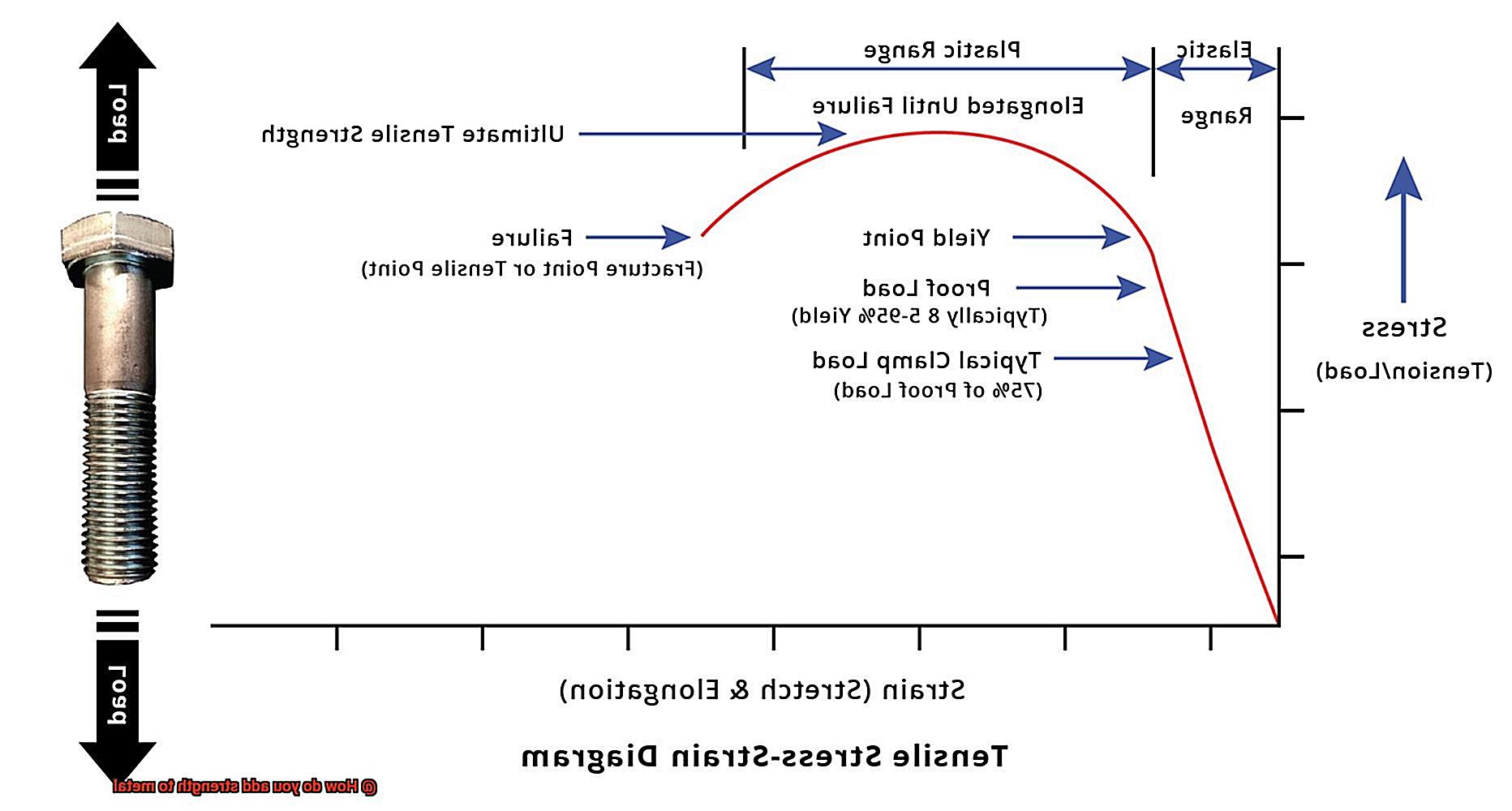It’s the backbone of countless industries, but sometimes it needs a little oomph to tackle tough challenges. That’s where the magic of strengthening metal comes in. By cranking up its mechanical properties, we can take metal from ordinary to extraordinary.
In this blog post, we’re diving headfirst into the world of beefing up metal. We’ll explore methods like alloying, heat treatment, and cold working that can turn your average hunk of metal into a superhero. Whether you’re an engineer, manufacturer, or just a curious cat who loves all things practical and powerful, get ready for a wild ride where strength meets metal.
Alloying
Contents
Alloying, the process of combining two or more metals to create a new material with enhanced properties, is a widely used method to add strength to metal. This technique involves melting and mixing the metals together, resulting in the formation of a solid solution.
The beauty of alloying lies in its ability to customize metal properties according to specific requirements. By selecting different metals and varying their proportions, engineers can tailor the strength, durability, and other characteristics of the alloy to suit particular applications. Whether it’s improving corrosion resistance or increasing hardness, alloying provides the flexibility to meet diverse needs.
Alloys can be broadly classified into two types: substitutional alloys and interstitial alloys. Substitutional alloys involve atoms of the constituent metals that are similar in size, allowing them to replace each other in the crystal lattice structure. This results in a homogeneous mixture with improved strength. On the other hand, interstitial alloys incorporate smaller atoms into the spaces between larger atoms in the lattice structure, creating localized stress and enhancing strength and hardness.
One of the most well-known examples of alloying is steel production. By alloying iron with carbon and other elements like manganese, nickel, and chromium, engineers can create different types of steel with varying properties. Adjusting the carbon content and incorporating other elements allows for the production of stainless steel, high-strength steel, or tool steel.
Alloying elements such as chromium, tungsten, molybdenum, and vanadium are commonly used to enhance the strength of steel. These elements form various compounds within the steel matrix, contributing to toughness, wear resistance, and high-temperature capability.
But alloying isn’t limited to steel; it is extensively used in the production of other metals and alloys as well. Aluminum alloys, for example, are widely employed in industries such as aerospace and automotive due to their excellent strength-to-weight ratio. Copper alloys like bronze and brass are known for their corrosion resistance and versatility in applications like electrical wiring and plumbing.
In addition to improving mechanical properties, alloying can also enhance the aesthetic appearance of metals. Gold, for instance, is often alloyed with silver or copper to create different colors and increase hardness for jewelry making.
Heat Treatment
Heat treatment techniques such as annealing, normalizing, quenching, tempering, and surface hardening are essential tools in the metallurgical world. These processes allow engineers to customize metal properties according to specific needs and improve the strength, durability, and other desired characteristics of metal materials.
Firstly, annealing is a gentle approach to heat treatment. By heating the metal to a high temperature and allowing it to cool slowly, annealing relieves internal stresses, refines the grain structure, and improves the metal’s ductility and toughness. It can be applied to various metals such as steel, copper, and aluminum.
Similarly, normalizing is a process that involves cooling the metal in still air instead of slow cooling like annealing. This refines the grain structure, improves mechanical properties, and enhances machinability. Normalizing is commonly used for structural steels and cast iron.
On the other hand, quenching is the rapid cooling technique that gives metals their hardened state. The heated metal is quickly immersed in a quenching medium like oil or water, causing a transformation in the microstructure that increases hardness. However, this rapid cooling can also introduce internal stresses, leading to potential risks like cracking or distortion.
To balance out the hardness achieved through quenching, tempering comes into play. By reheating the hardened metal to a specific temperature and then cooling it down again, tempering reduces hardness and brittleness while maintaining or improving other desired properties like strength and toughness. The exact temperature and time of tempering depend on the specific requirements of the metal being treated.
Lastly, surface hardening techniques focus on strengthening only the outer layer of a metal component. Methods like case hardening introduce carbon or nitrogen into the surface layer, creating a hardened case while maintaining a softer core. This technique is commonly used for gears, shafts, and other components that require wear resistance.

It’s important to note that while heat treatment techniques can significantly enhance the strength and durability of metal materials, there are potential risks associated with each method. Improper heating or cooling rates, incorrect temperatures, or inadequate control can lead to undesirable effects like excessive hardness, brittleness, or even component failure. Therefore, it is crucial to have a deep understanding of the specific requirements and limitations of each heat treatment technique to ensure optimal results.
Surface Treatments
Surface treatments are a fascinating and essential aspect of enhancing the strength of metal. Metallurgical engineers carefully consider factors such as the composition of the metal, desired properties, and specific application before implementing these treatments. By combining techniques like plating, nitriding, heat treatment, surface coatings, and shot peening, they can create metal components that are not only strong but also resistant to wear, corrosion, and other environmental factors.
Let’s dive deeper into some of these surface treatment methods. Plating, or electroplating, involves depositing a layer of metal onto the base metal’s surface using an electric current. This additional layer not only enhances strength and durability but also improves the metal’s aesthetic appearance.
Nitriding, on the other hand, introduces nitrogen into the surface layer of the metal by exposing it to a nitrogen-rich atmosphere at high temperatures. This process forms a hard nitride layer that significantly increases hardness and wear resistance. Nitriding is especially effective for strengthening steel components.
Heat treatment is another widely used technique for surface strengthening. It involves heating the metal to high temperatures and then rapidly cooling it to alter its microstructure. This process can change the metal’s hardness, strength, and toughness. Annealing, tempering, quenching, and case hardening are different heat treatment techniques with specific applications depending on the desired outcome.
Surface coatings are crucial for improving the strength of metal as well. Coatings can be applied to create a protective layer that enhances resistance to wear, corrosion, and other environmental factors.
Painting, powder coating, and chemical vapor deposition (CVD) are common coating methods that also enhance the metal’s aesthetic appearance.
Lastly, shot peening is a technique that involves bombarding the metal surface with small metallic or ceramic particles at high velocities. This process induces compressive stress in the metal’s surface layer, strengthening the material and improving its fatigue life. Shot peening is particularly beneficial in industries such as aerospace and automotive.
Mechanical Processes
In the field of metalworking, there are several mechanical processes that can be employed to add strength to metal. One such process is cold working, also known as strain hardening or work hardening.
Cold working involves deforming the metal at room temperature, typically through processes such as rolling, forging, or drawing. This deformation causes dislocations within the metal’s crystalline structure, which in turn increases its strength and hardness.
Another mechanical process that can enhance the strength of metal is heat treatment. Heat treatment involves heating the metal to a specific temperature and then cooling it at a controlled rate. This process alters the microstructure of the metal, leading to changes in its mechanical properties. For instance, heating and quenching steel can result in the formation of martensite, a hard and brittle phase that significantly improves the material’s strength.
Additionally, metal can be strengthened through processes like shot peening and shot blasting. Shot peening involves bombarding the surface of the metal with tiny spherical particles, while shot blasting uses larger particles propelled at high velocity. These processes create compressive stresses on the surface of the metal, which helps to increase its resistance to fatigue and improve overall strength.
Welding is another mechanical process commonly used to add strength to metal. By joining two or more pieces of metal together through welding, the resulting structure can often exhibit increased strength compared to individual components. The heat generated during welding causes localized melting and subsequent solidification, creating a metallurgical bond between the welded parts.
Lastly, metal can be strengthened through various forming processes. For example, deep drawing involves stretching a sheet of metal into a three-dimensional shape using a punch and die. This process not only shapes the metal but also aligns its grain structure, resulting in improved strength and durability.
Welding Techniques
Welding is a crucial process in the world of metalwork, providing the means to join pieces together and create structures and products that can withstand the test of time. In this discussion on welding techniques, we will explore the various methods used to achieve these strong and durable bonds.
One of the most widely employed techniques in industries such as construction, manufacturing, and automotive is arc welding. This technique harnesses the power of electricity to create an arc between an electrode and the metal pieces being joined. As the arc generates intense heat, it melts the edges of the metal, allowing them to fuse together upon cooling. Within arc welding, there are different types to consider. Shielded metal arc welding (SMAW), also known as stick welding, employs a flux-coated electrode to facilitate the fusion process. Gas metal arc welding (GMAW), also referred to as MIG welding, utilizes a continuous wire electrode and shielding gas to protect the weld from atmospheric contamination. Tungsten inert gas welding (TIG) involves using a non-consumable tungsten electrode and requires the use of a filler material to complete the weld joint.
Spot welding is another widely adopted technique, especially in industries that demand high-speed production, like automotive manufacturing. This method involves creating small, localized welds in specific areas of the metal pieces. To achieve this, two copper alloy electrodes clamp the metal together and deliver an electric current that generates resistance heating at precise points. As a result, these points melt and form what is known as a weld nugget.
Gas welding is another versatile technique that relies on the use of a flame to heat the metal surfaces before adding a filler material to create the weld joint. This technique necessitates an oxyfuel gas torch that combines fuel gases such as acetylene or propane with oxygen to generate a high-temperature flame. Gas welding can be applied to various types of metals and proves particularly useful when working with thin or delicate materials.

Lastly, we have laser welding, a modern and highly precise technique that employs a focused laser beam to melt and join metal pieces together. This method offers unparalleled control and can produce high-quality welds with minimal distortion. It finds extensive use in industries that require intricate welding, such as electronics manufacturing or medical device fabrication.
Nanotechnology
Nanotechnology is a game-changer in the world of metal strengthening, opening up new possibilities to enhance the mechanical properties of metals. Through the manipulation of materials at the nanoscale, scientists and engineers are revolutionizing the way we strengthen metals, unlocking their full potential.
One powerful technique in nanotechnology is nanoparticle reinforcement. By incorporating nanoparticles, such as carbon nanotubes or graphene, into metal structures, we can dramatically enhance their strength and stiffness. These tiny particles possess unique properties at the nanoscale that allow them to interact strongly with the surrounding metal matrix. This interaction forms a robust interface that hinders dislocation movement and improves overall strength.
Another exciting aspect of nanotechnology is the ability to tailor the microstructure of metals. By precisely controlling the size, shape, and distribution of nanoparticles within a metal matrix, researchers can customize its mechanical behavior. For instance, aligning carbon nanotubes in a specific orientation within a metal can create a composite material with exceptional strength along a particular direction.
Nanocoatings are another powerful tool offered by nanotechnology. These thin films, composed of nanosized particles or layers, can be applied onto metal surfaces to enhance their strength. Nanocoatings provide improved wear resistance, corrosion protection, and even self-healing capabilities to the underlying metal. By engineering the composition and structure of these coatings, we can achieve specific properties for different applications.
For example, incorporating nanoparticles with high hardness, like titanium nitride or diamond-like carbon, into a metal surface through nanocoatings significantly enhances its wear resistance. This is particularly beneficial in industries where metal components are subjected to friction and abrasion.
Furthermore, nanocoatings can protect metals from corrosion in harsh environments by incorporating nanoparticles with corrosion-inhibiting properties, such as zinc oxide or cerium oxide. This is crucial for applications in marine, automotive, and infrastructure industries where metals are constantly exposed to corrosive elements.
Benefits of Strengthening Metal
Strengthening metal has numerous benefits that can greatly improve the performance and lifespan of metal components. The advantages of strengthening metal are as follows:
- Increased durability: Strengthening metal enhances its resistance to wear and tear, ensuring that it lasts longer even in demanding conditions. This is particularly important in industries where metals are subjected to harsh environments or heavy usage.
- Improved load-bearing capacity: Strengthening metal allows it to withstand higher levels of stress and pressure without deforming or failing. This is crucial in industries such as construction and automotive, where heavy loads are involved.
- Enhanced resistance to corrosion: Certain strengthening techniques make the metal more resistant to rust and other forms of corrosion. This is especially important in outdoor or corrosive environments, as it increases the lifespan of the materials and reduces maintenance requirements.
- Heat resistance: Strengthening metal improves its ability to withstand extreme heat conditions without losing its structural integrity. This is particularly important in industries such as aerospace and power generation, where high temperatures are involved.
- Fatigue resistance: Strengthening metal makes it more resistant to fatigue failure caused by repeated loading and unloading cycles. This ensures its longevity and reliability, making it suitable for applications where durability is crucial.
- Impact resistance: Strengthening metal makes it less susceptible to deformation or fracture when subjected to sudden impacts or shocks. This is beneficial in applications such as automotive crash zones or machinery parts, where the metal needs to withstand unexpected forces.
- Dimensional stability: Strengthened metal is less prone to dimensional changes caused by temperature fluctuations or other external factors. This ensures that the metal maintains its shape and dimensions over time, which is essential for precision engineering applications.
Considerations When Strengthening Metal
When it comes to strengthening metal, there are several crucial considerations to bear in mind. First and foremost is the type of metal being used. Different metals possess distinct properties and respond differently to strengthening techniques. For instance, steel is renowned for its high strength and durability, making it ideal for construction and manufacturing. On the other hand, aluminum is lightweight and commonly employed in aerospace applications. Understanding the properties of the metal being used is paramount in determining suitable strengthening methods.
Another important consideration is the desired strength level. Strengthening metal can involve various techniques, each with its own effectiveness in increasing strength. Heat treatment, for example, alters the microstructure of steel to enhance its strength. Cold working, such as rolling or forging, can deform the crystal structure of certain metals to improve their strength. The desired strength level will dictate the technique or combination of techniques to employ.
The intended application of the metal is also a critical factor to consider. Different applications call for different levels of strength and durability. Structural components must withstand heavy loads and vibrations, while decorative pieces may only require moderate strength. Understanding the specific requirements of the application will aid in determining the most appropriate strengthening methods.
Lastly, available resources and techniques should be taken into account. Methods such as heat treatment, cold working, alloying, and surface treatments can be used to strengthen metal. Each method has its own advantages and limitations. Factors like cost, time constraints, equipment availability, and expertise should be considered when selecting which method or combination of methods to employ.
WjftTseIfpM” >
Conclusion
In conclusion, there are multiple techniques available to bolster the strength of metal and unleash its full potential. One widely employed method is alloying, which involves blending different metals to form alloys with enhanced properties. By carefully selecting the metals and their proportions, engineers can tailor the alloy’s strength, durability, and other characteristics to meet specific requirements.
Heat treatment techniques such as annealing, normalizing, quenching, tempering, and surface hardening are indispensable tools in fortifying metal. These processes allow for customization of metal properties based on specific needs and improve strength, durability, and other desired traits.
To further augment the strength of metal, surface treatments like plating, nitriding, heat treatment, surface coatings, and shot peening come into play. These treatments not only safeguard against wear and corrosion but also bolster overall strength.
Mechanical processes such as cold working, heat treatment, shot peening, welding techniques (arc welding and spot welding), and forming processes can all be harnessed to reinforce metal. Through these processes, the microstructure of the metal is altered or strong bonds are created between metal pieces.
The realm of nanotechnology presents exciting possibilities for strengthening metal. Incorporating nanoparticles into metal structures or applying nanocoatings can significantly enhance strength and stiffness while providing wear resistance and corrosion protection.
The advantages of strengthening metal include heightened durability, improved load-bearing capacity, enhanced resistance to corrosion and heat, fatigue resistance, impact resistance,and dimensional stability. However,it is crucial to consider factors such as the type of metal being used,the desired level of strength for the application at hand,and available resources and techniques when determining which method or combination of methods will yield optimal results.






